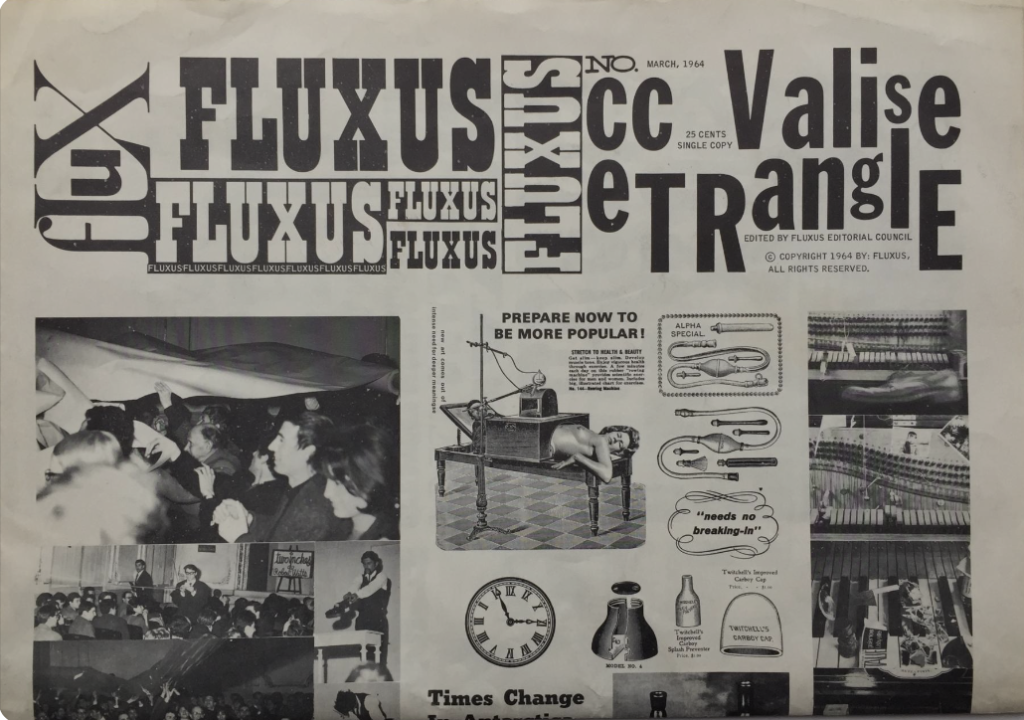In 1957, Fluxus was started by artists who had learned by John Cage at New School for The Social Research and who had watched the performances of Karlheinz Stockhausen. Especially the artists who had studied under John Cage in The States was influenced a lot, such as George Brecht, Al Hansen, Dick Higgins, Allan Kaprow, Jackson Mac Low, George Sgal, Jim Dine, La Monte Young, etc. After 1958, the wind of Fluxus blowed up at Soho Canal Street in New York, which main was Dick Higgins and his wife Alison Knowles and after that Ay-o, Yoko Ono and Mieko Shiomi took participate on. There were two performances which were the starting point of Fluxus : One is the performance opened by La Monte Young at studio “Loft” in Chambers Street where located on the top of Soho from 1960 December to 1962 January, and the another is the performance that opened at studio “AG” in Madison located on the top of New York form March of 1961 to July. At this time, the meeting of George Maciunas, the boss of studio AG, and La Monte Young influenced a lot on the publication which could encourage the communication of Fluxus members, and finally the publication “Anthology” was published with contents from Fluxus members who was staying on various countries, which let people know about Fluxus. However Maciunas wanted to make the personal publication “Fluxus”, pushing ahead to publish, but the studio AG went bankrupt in the process of printing, so the publication “Fluxus” could not come out to world and Maciunas was heading to Germany.
Nam June Paik, in Japan because of Korean-war, went Germany to study by the respect for Arnold Scheonberg in 1956, and at this time he met Maciunas who just came Germany. After this meeting, Nam June Paik met John Cage also through the lecture of John Cage in Darmstaurt, since of this, Nam June Paik’s view of performance arts settled in. Maciunas could meet a lot of various artists through Nam June Paik who was already flowing together in Europe. Maciunas could get a bond of sympathy about similar view of art works of them, which developed to performance, so they performed “Fluxus international festival of new music” at September in 1962. After this, Maciunas published “Fluxus” and named their movement “Fluxus”.

Since Fluxus International Festival of New Music, Fluxus members had been many countries in Europe, communicating with the artists who did experimental arts. The artists who had communicated constantly and agreed with the movements of Fluxus did a role of accelerating Fluxus movement with Fluxus members who were staying in The States.
Fluxus movement is a little bit different from other movements, the biggest characteristics are world wide movements and no restriction in genre. Although the beginning of Fluxus were the USA and Germany, after a while, Fluxus became world wide movements through many countries in Europe and Asia like Korea or Japan. Because of this, Fluxus members had worked in many countries in the world, being art movements, applying various media from various cultures, which made this have no restriction of genre.
Fluxus started in the base of opposite about Modernity. Modernity, which started to break the traditional artistic form, but tended to be in the cast of basic artistic form. For example, Serialism started from Scheonberg was innovative and also broke the artistic form but they used classical instruments for his pieces yet, which is basic artistic form. So Fluxus tended to extend the range of media for arts, and used more various combinations of the media, hoping that arts go into the range of life. That is, Fluxus movements can be seen that has agreements with post-modernism, which opposes the formalismic theory of modernity, and also be interpreted to extension of realisation about cast or media which arts have.